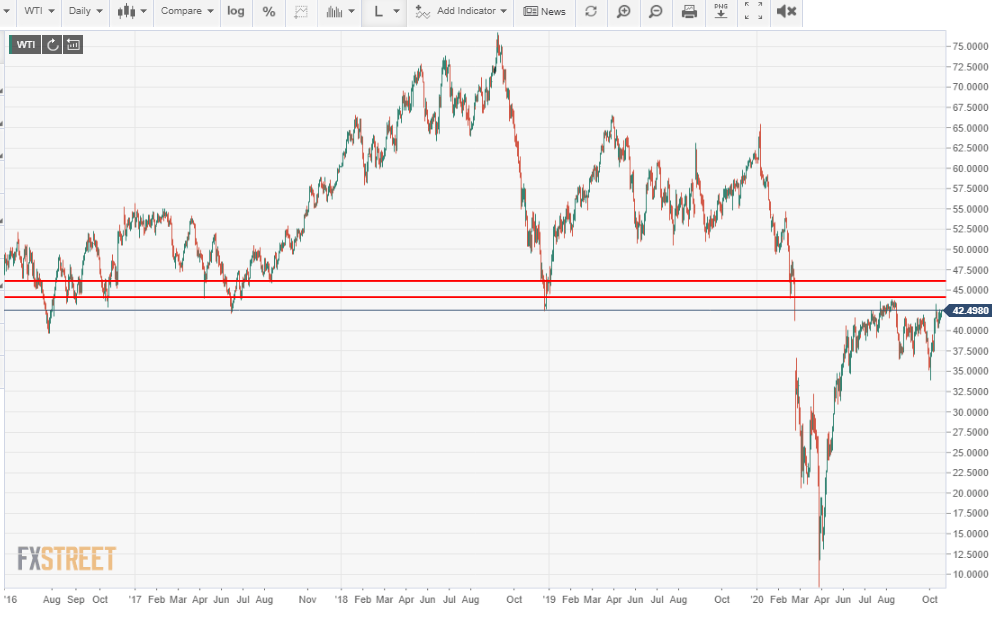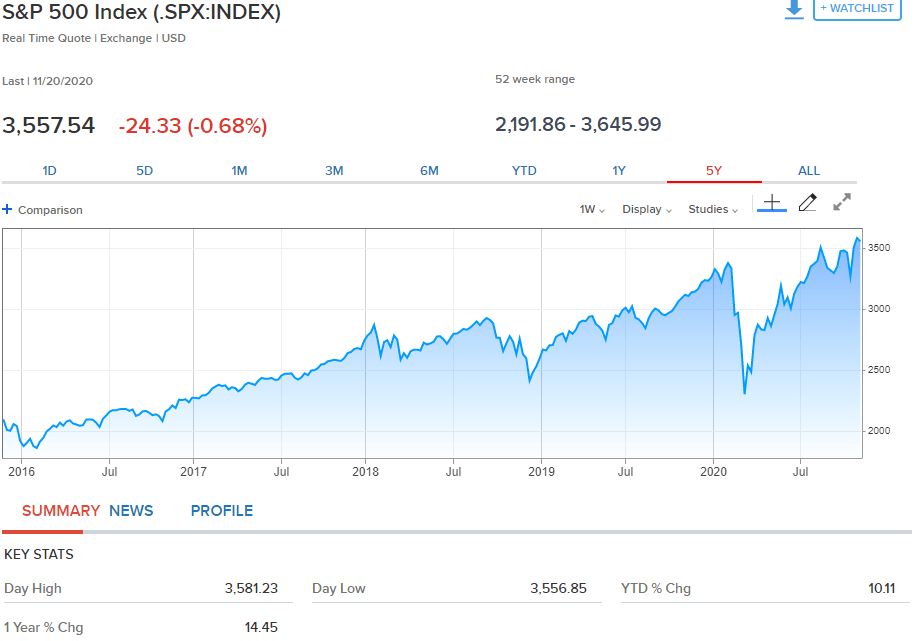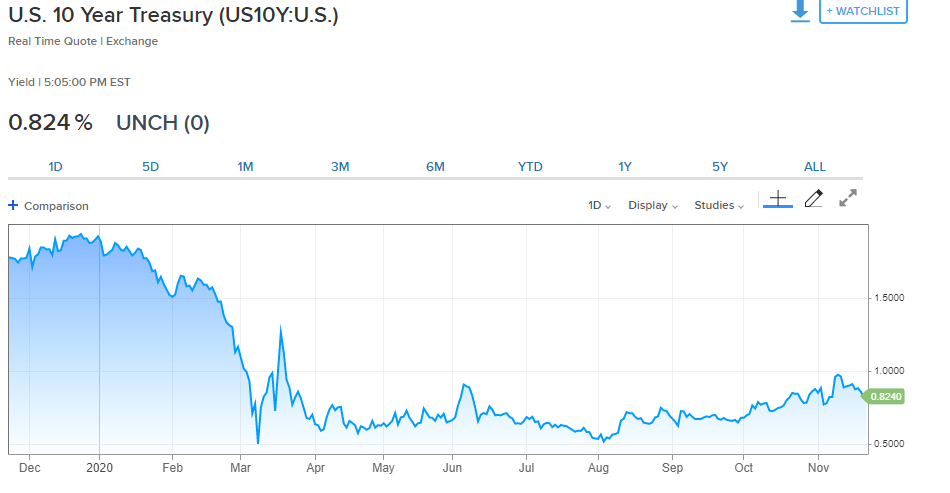- WTI closes at $42.44, its highest since September 1.
- Oil has gained 13.9% in November but remains below the March break.
- US equities have set new records predicting recovery.
- Atlanta Fed GDPNow estimates 5.6% annualized growth in Q4.
- Dollar will respond to US economic growth which fracking and inexpensive oil facilitates.
The recovery in crude oil, is like almost everything else in the global economy, a one variant function. Tame the COVID-19 pandemic and all else follows.
West Texas Intermediate (WTI) prices rose 1% on Friday, capping a 5.1% week and a 13.9% month. This is the fourth time since the great pandemic collapse in the spring that crude has approached the underside of its three year range before COVID-19. Each time it has failed to break through.
The $44-$46 price band has been a chasm that traders have been unwilling to cross.
West Texas Intermediate
It is not whether a recovering global economy can drive prices back above $50. It will.
One question is timing. When will traders have sufficient confidence that the recovery is nearing to speculate on prices? Or to put it more directly, when can we be sure that the pandemic will not derail the economy yet again.
A second question is how far can prices rise with idle fracking fields in North American waiting for activation? The answer is the pricing and cost structure has been permanently altered by vast new supplies of crude oil. Barrel prices above $75 are likely a thing of the past.
West Texas Intermediate
 US economy: If not a V then what?
US economy: If not a V then what?
The recovery from the -31.4% crash in GDP in the second quarter with a 33.1% burst in annualized growth in July, August and September, is textbook for the much-derided V-shaped recovery, at least for economic activity.
US GDP, annualized
Labor market metrics have not prospered to the same degree. The unemployment rate has more than halved from 14.7% in April to 6.9% in October but it is still almost double its 3.5% reading in February. Nonfarm Payrolls have replaced or rehired just 54% of the 22.16 million workers displaced by the pandemic lockdowns in March and April. Many of those service sector jobs have disappeared.
For the moment the GDP recovery is predicted to continue into the fourth quarter. The Atlanta Fed GDPNow model estimates the economy is expanding at a 5.6% annual rate in the final quarter. That is an excellent rate at any time, in current circumstances it is both surprising and very welcome.
Equities vs WTI
The contrast between US equity averages which have topped their per-pandemic records and West Texas Intermediate is striking.
In eight months the Dow has gained an astonishing 61% from its March 23 panic low at 18591 to close at a new record of 29950 on November 16. The prior high on February 12th was 29,551. The new record is just 1.4% above the old, but considering the conditions since March, it is one of the more remarkable moves in financial history.
The S&P 500 has jumped 62% from its March low to last week's high at 3,626. It is 7% over it per-pandemic high of 3386 from February 19 and has seen a good portion of trading since August 8 above the old record.
 CNBC
CNBC
Price action in both markets discounts the future. If you think the economy is headed for a boom once the pandemic loosens its grip, the demand for crude oil will rise as surely as equity profits.
The Fed and fracking
There are two main differences in pricing, one for stocks and the other specific to oil, that have supported equities and inhibited crude.
The Federal Reserve has made low interest rates the cornerstone of pandemic banking policy. The governors cut the fed funds rate to 0.25% in early March and they have kept the effective rate even lower with a bond buying program.
The impact of this is evident in the yield on the 10-year Treasury. On the last day of 2019 the 10-year Treasury yield was 1.919% and on February 5 it was 1.649%. A little over one month later on March 9 the same yield was 0.498%, an all-time low. On Friday the close for this bond was 0.824% less than half the yield before the Fed policy.

CNBC
In providing liquidity to the US economy the Fed has also supplied it to the equity markets. Some of that funding and the ability to borrow at near record low cost has certainly made its way to stocks in search of return boosting prices.
The advent of fracking in the United States and Canada has changed oil production and supply dramatically. From being a major importer of crude, the US has become a net-exporter. The US is now the world's largest producer of energy, specifically oil and natural gas. The US and Canada also have vast untapped supplies of oil and natural gas.
These factors and the facility of US producers in reducing production costs have permanently brought down the price of oil.
Conclusion and the dollar
Equities and WTI operate with the same set of economic expectations. Prices, however, are the product of two very different markets.
Interest rates and liquidity provisions from the central bank have given the financial sector a temporary boost.
Fracking has permanently increased the supply of crude oil the industry is able to produce. North American shale drillers have become the swing producers in the global market. They are unrestricted by government quotas in the US or Canada. Their restriction is profitability. As the market adage goes-high prices are their own cure.
With the Federal Reserve projected in its own estimates to be on hold until the end of 2023 the dollar next year will depend on US economic growth for support. Low energy prices are a boon to any economy. For the worlds largest user of energy, the proportional advantage is substantial.
Information on these pages contains forward-looking statements that involve risks and uncertainties. Markets and instruments profiled on this page are for informational purposes only and should not in any way come across as a recommendation to buy or sell in these assets. You should do your own thorough research before making any investment decisions. FXStreet does not in any way guarantee that this information is free from mistakes, errors, or material misstatements. It also does not guarantee that this information is of a timely nature. Investing in Open Markets involves a great deal of risk, including the loss of all or a portion of your investment, as well as emotional distress. All risks, losses and costs associated with investing, including total loss of principal, are your responsibility. The views and opinions expressed in this article are those of the authors and do not necessarily reflect the official policy or position of FXStreet nor its advertisers. The author will not be held responsible for information that is found at the end of links posted on this page.
If not otherwise explicitly mentioned in the body of the article, at the time of writing, the author has no position in any stock mentioned in this article and no business relationship with any company mentioned. The author has not received compensation for writing this article, other than from FXStreet.
FXStreet and the author do not provide personalized recommendations. The author makes no representations as to the accuracy, completeness, or suitability of this information. FXStreet and the author will not be liable for any errors, omissions or any losses, injuries or damages arising from this information and its display or use. Errors and omissions excepted.
The author and FXStreet are not registered investment advisors and nothing in this article is intended to be investment advice.
Recommended Content
Editors’ Picks
AUD/USD remained bid above 0.6500

AUD/USD extended further its bullish performance, advancing for the fourth session in a row on Thursday, although a sustainable breakout of the key 200-day SMA at 0.6526 still remain elusive.
EUR/USD faces a minor resistance near at 1.0750

EUR/USD quickly left behind Wednesday’s small downtick and resumed its uptrend north of 1.0700 the figure, always on the back of the persistent sell-off in the US Dollar ahead of key PCE data on Friday.
Gold holds around $2,330 after dismal US data

Gold fell below $2,320 in the early American session as US yields shot higher after the data showed a significant increase in the US GDP price deflator in Q1. With safe-haven flows dominating the markets, however, XAU/USD reversed its direction and rose above $2,340.
Bitcoin price continues to get rejected from $65K resistance as SEC delays decision on spot BTC ETF options

Bitcoin (BTC) price has markets in disarray, provoking a broader market crash as it slumped to the $62,000 range on Thursday. Meanwhile, reverberations from spot BTC exchange-traded funds (ETFs) continue to influence the market.
US economy: slower growth with stronger inflation

The dollar strengthened, and stocks fell after statistical data from the US. The focus was on the preliminary estimate of GDP for the first quarter. Annualised quarterly growth came in at just 1.6%, down from the 2.5% and 3.4% previously forecast.
